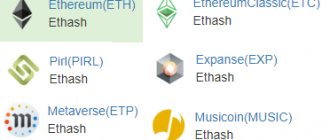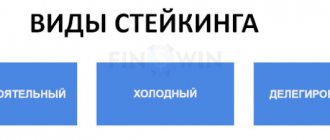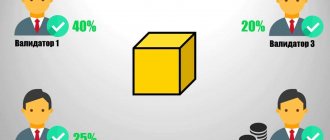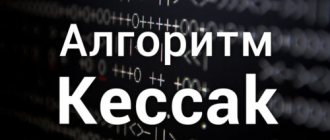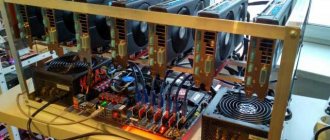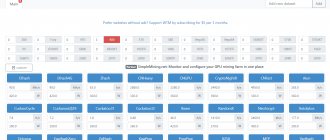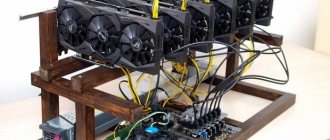Every person, without exception, who begins to study cryptocurrencies, is faced with such concepts as Proof-Of-Work and Proof-Of-Stake. In short, these are blockchain consensus algorithms used to confirm transactions and create blocks.
PoW and PoS are the most well-known and at the same time significantly different from each other. In this article we will explain how Proof-Of-Work works, how it differs from Proof-Of-Stake, as well as what coins can be mined and what equipment is needed.
- What is the Proof-Of-Work algorithm
- Difference between PoW and PoS
- Hash algorithms working with PoW
- Equipment for mining on Proof-Of-Work
- Best Mining Pools on Proof-Of-Work BTC.com
- AntPool
- F2P Pool
- SlushPool
- ViaBTC
What is the Proof-Of-Work algorithm
Proof-Of-Work Algorithm
Proof-Of-Work
(English: “proof of work”) is an algorithm for the functioning of cryptocurrencies based on proof of work performed - miners solve the problem of forming a block and confirm transactions between all network participants. The main criterion is the power of the computer device used.
At the same time, the complexity of the network (hashrate) depends on the total amount of capacity, users and load on it. Security is ensured by the fact that the hash of each block contains the hash of the previous one, making it impossible to disrupt the order of creation.
To carry out this work, enormous computing power is required, which is provided by a large number of participants. However, this also leads to certain problems, for example, high energy costs.
But there are other challenges associated with Proof-Of-Work. As the network develops, the requirements for computing power also increase. This is required by cryptocurrency algorithms. It is for this reason that Bitcoin mining on weak equipment has become completely unprofitable.
The main goal of Proof-Of-Work is to protect the distributed system from various attacks such as DDos, spam, double spending, and so on. The essence of the algorithm comes down to complete transparency of the network with the ability to simply and quickly check the result.
Simply put, the Proof-Of-Work algorithm provides the network with the ability to verify that the miner who adds a new block to the blockchain has performed the calculations correctly.
This video describes in simple words what Proof-Of-Work is:
What is Proof-Of-Work and how it works
The connection between the algorithm and the cryptocurrency space
In the very first virtual currency, PoW is necessary to achieve consensus in the network. Since multiple versions of the blockchain can exist for each user at any given time, the algorithm determines which version is reliable. To implement his idea, Nakamoto used the developments of the above-mentioned Hashcash project, slightly modifying the finished function (adding a mechanism for changing its complexity, which depends on the total computing power of all network nodes). The finished function is called SHA-256.
The PoW algorithm is necessary for network nodes to verify that the miner has carried out calculations. The latter performs calculations of complex algorithms, as a result of which a new generated block (“cell”) is added to the block chain, storing a certain number of records about completed transactions. The proof-of-work mechanism attempts to find a hash of the node's header, which contains a reference to the previous "cell" and the total value of all operations placed in the newly generated node. The hash indicators correspond to the established degree.
Difference between PoW and PoS
Income from mining
Proof-Of-Stake translated from English means “confirmation of ownership share.” Unlike Proof-Of-Work, it does not require a huge amount of power. In PoS, the formation of the blockchain depends on the share of the cryptocurrency owned by the miner. That is, the probability of solving a problem is directly proportional to the number of user tokens. Accordingly, the more cryptocurrency is in the account, the higher the likelihood of receiving a reward.
At the same time, in the blockchains of some cryptocurrencies based on Proof-Of-Stake, there is no reward for solving the problem, and the miner receives the reward for commissions from transactions.
And if the concept of Proof-Of-Work appeared back in 1999, as protection of email from spam, then PoS has a younger history. The idea of Proof of Ownership appeared in 2011 specifically for cryptocurrencies, as a solution to the main problem of Proof-Of-Work - the huge consumption of electricity.
The main difference between PoW and PoS is energy consumption. In Proof-Of-Work, you will need equipment for mining, which also includes the cost of its maintenance and electricity. Secondly, it is enough to buy cryptocurrency and keep it in your wallet.
When mining on Proof-Of-Work, the probability of generating a block depends on the power of your equipment or the overall power of the pool you join. In PoS, income depends on the amount of cryptocurrency. At the same time, the longer you own it and do not withdraw it, the more the chance of generating a block increases each time.
☝️
In Proof-Of-Work, to increase earnings, you will need to increase equipment capacity, along with which costs will also increase.
But in PoS, not everything is so simple. If the number of coins sent for mining remains unchanged, profits may fall.
Let’s assume that 1% of the tokens of the total number of coins in mining are frozen, which means the reward will be equal to 1%. But as soon as a large holder (“whale”) enters the game, the percentage of your coins from the total number will decrease and, accordingly, your earnings will also fall.
But if the exchange rate falls, both PoW and PoS miners will suffer losses, but with some difference. Proof-Of-Work miners will continue to receive electricity bills, while receiving a smaller reward when converted to fiat currency, and PoS miners will only lose the value of their stake.
Let's say you purchased the Tezos cryptocurrency for $1 and froze it. But tomorrow its price dropped to $0.50. In this case, the miner will lose 50% of the liquidity of his asset, but will not incur any costs, the tokens will still be in the account and generate income.
Of course, one might think that PoS is significantly superior to Proof-Of-Work due to lower costs. But it also has its drawbacks, mainly related to decentralization.
For example, cryptocurrencies based on this algorithm are protected from a 51% attack, but instead, control over the network can be seized by large coin holders, who hold 51% of all tokens.
Buterin's plan
Vitalik Buterin is considered one of the central figures of the project. He is an ardent supporter of the transition of Eth to Proof-of-Stake, despite the objections of the community itself and experts, namely that this leads to the centralization of the project, an outflow of users, a drop in its reliability and increased interest from financial regulators who are ready to equate tokens with securities. For example, on September 19, 2016, Buterin spoke at the Devcon2 developer conference in Shanghai and stated that the transition to PoS would not occur earlier than the summer of 2022, and in general could last until 2022.
On December 10, 2022, Buterin flooded Twitter with a long post proving the advantages of decentralized blockchains in general and those built on PoS in particular. In a March 2022 post on Reddit, he stated that the transition was not as simple a decision as previously thought. As a result, the transition to a new algorithm was constantly postponed either to the end of 2022, or to the winter of 2022, and then there was talk of a hybrid algorithm between PoW and PoS. The main network has become overgrown with all sorts of testnets, sidechains and other tools designed to test the future transition. The main one is Beacon Chain as the foundation of the future Ethereum 2.0 main blockchain. It is already possible to make transactions “in the style” of PoS.
Finally, on June 2, 2022, Buterin spoke about numerous problems in the transition to PoS. He complained about the human factor, which delayed the launch and the transition to a more environmentally friendly and less expensive option for reaching consensus. If, according to the technical standard, it was initially expected to take three months, it has already stretched to 18. In the best case, the hybrid version of PoW/PoS will work in the second half of 2022. In addition, the developers expected to quickly switch to PoS within one year, but in fact they are struggling task for about 6 years now.
As a result, as of mid-October 2022, only Phase 0 has been successfully implemented and completed. It took place in November last year, and a year later it was supposed to move into Phase 1 to gradually merge Beacon Chain on PoS with the main network (Eth1). Currently, $3 billion of validators’ collateral is concentrated in the sidechain. Due to high competition with other blockchains, as well as the busyness of developers, the merger of Eth1 and Eth2 was postponed until the end of the year, until the Shanghai hard fork.
But now there is a problem with the “complexity bomb”, which must be constantly postponed so as not to overload the network. The solution to the issue of its postponement was included in the EIP-4345 update. This means that the network merger is delayed until at least May 2022. Investors responded by withdrawing funds, as they expected to switch to PoS before the end of 2022. Now, at best, they will have to wait about another year. This affects the Ethereum rate, which is gradually falling, now trading at 3,800 USD versus 4,150 on May 11, 2022.
Hash algorithms working with PoW
Cryptocurrency hashing algorithms
The first cryptocurrency working on Proof-Of-Work (and indeed the first) was Bitcoin. It uses the SHA-256 hashing algorithm. However, after the first fork and the creation of the Litecoin cryptocurrency in 2013, a new algorithm appeared - Scrypt.
At that moment, progress did not stop for a minute, and developers were looking for a more effective solution for cryptocurrencies, which gave rise to quite a few solutions based on Proof-Of-Work.
☝️
Six-Hash turned out to be interesting, which is a combination of six types of block hashing.
The essence of this algorithm was that to start minimal mining, a miner needed six ASIC chips at once. Thus, the number of users decreases, but at the same time the total capacity does not decrease. Six-Hash was implemented in the Quark cryptocurrency.
This algorithm later spawned upgrades such as X11 (DASH), X13 (Bitcoin Diamond, Stratis, Navcoin), X14 (BERNcash), X15 (Kobocoin), and X17 (Verge). Based on the name, it is clear that they combined an even larger number of algorithms. But initially there were no serious requirements for equipment - it was possible to mine even on a CPU. One of the most popular coins using such algorithms is DASH, but today there are hundreds of them.
Next are various variants of the Scrypt algorithm - Scrypt-N (Vertcoin), Scrypt-jane, CryptoNote (Monero) and so on. In them, the developers tried to reduce the likelihood of a “51% attack,” increase GPU performance, and also added other useful features.
List of popular PoS coins
There are quite a few coins, but the most popular of them are:
- LEOcoin. If the user owns more than 50 thousand coins, they will provide a yield of 20% per annum. Traded on 5 major exchanges, system capitalization is more than $24 million.
- ReddCoin. It has a low rate of return of 5%, but this coin is interesting as an investment with the prospect of great growth. The capitalization of the system exceeded $41 million. Trading is carried out on Bittrex and on 7 exchanges.
- ClubCoin. The yield is 20% per annum, but trading is carried out only on 2 exchanges, including the well-known Bittrex. Capitalization exceeds $43 million.
- NovaCoin. The creators of this coin promise that its profitability will be 100% per annum. Capitalization over $8.5 million The coin is traded on 8 exchanges.
- OK Cash (OK). The yield is 20% per year, trading is carried out on Bittrex in small volumes.
When choosing a POS cryptocurrency, you need to focus on the interest rate, preferably it starts from 5% per year, on the other hand, if the interest rate is too high, this should serve as a signal that you need to be especially careful with such a cryptocurrency.
Equipment for mining on Proof-Of-Work
Equipment for mining on Proof-Of-Work
The most promising cryptocurrencies based on the Proof-Of-Work algorithm are currently
- Bitcoin;
- Litecoin
- Ethereum;
- Ethereum Classic;
- Monero;
- Quark;
- Bitcoin Cash;
- DASH;
- Zcash;
- Grin.
Mining on Proof-Of-Work can be carried out in three ways - through a video card, processor or ASIC. At the same time, in the case of top cryptocurrencies such as BTC, ETH and LTC, mining on the CPU is no longer relevant, and in order for GPUs to compete with integrated circuits, it is necessary to assemble a farm from several cards. Of course, there is also mining on a smartphone, but it is absolutely unprofitable.
If we consider Bitcoin mining specifically, then the right decision would be to buy an ASIC, since even the most serious GPU farms cannot compete with ASICs.
☝️
Current models at the moment are Antminer S7, S9 and D3 from ]Bitmain[/anchor].
On average, they show a power of 12 to 14 thousand Gh/s with an energy consumption of about 1350 Watts. To achieve such performance on a GPU, you will need more than a dozen video cards, which is significantly more expensive than buying an ASIC.
As for other cryptocurrencies, GPU mining is still relevant. But in any case, the most profitable solution is to assemble a farm. And here you can’t get by with just purchasing cards for mining. You will need a system with several PCI slots, the number of which is proportional to the number of GPUs, a motherboard, a powerful power supply, a good cooling system and a case.
☝️
At the moment, the most popular video cards for creating farms are AMD RX 480, RX 580 and Nvidia GTX 1050, 1060, 1070 and 1080.
Newer models are more expensive, which means the payback time increases significantly. That is why when creating farms you should proceed from the parameters price/total hashrate.
One way or another, when creating a farm, the main thing remains the motherboard, in which we are interested in the number of PCI slots, power supply and stable Internet access. Neither the processor, nor the RAM, nor the hard drive play a key role here.
At the assembly stage, you need to decide which cryptocurrency or which algorithm you are going to mine. Despite the fact that in theory you can mine any coin on a video card, there are still differences. For example, for mining Ethereum and tokens based on the Ethash algorithm, GPUs from AMD are more suitable, and if we are talking about Zcash, then cards from Nvidia are the right choice.
Mining calculators are very helpful with this choice. With the help of such services, you can clearly see which cryptocurrency is best to mine on a specific video card.
Also important is the indicator of energy consumption and the cost of electricity. The larger the mining farm, the greater the electricity consumption. Accordingly, in the final calculation of approximate income, you need to know exactly this expense parameter.
Bitcoin is the main cryptocurrency that can be mined on Proof-Of-Work.
Other Consensus Models
There are other consensus algorithms appearing on the market. Proof of Space proportionality factor is based on how much storage space the node has. There is also PoET (proof of elapsed time) and a number of other algorithms, most of which are still unproven.
To be fair, technology continues to evolve exponentially and there is no way to predict what might happen or upset the balance in the mining world. However, Hydrominer is structured in such a way that we can innovate as new ideas and technologies emerge. With multiple lines of business and services, you can quickly move between departments as needed to increase revenue.
The best mining pools for Proof-Of-Work
Mining pools on Proof-Of-Work
As mentioned above, the main problem of Proof-Of-Work is the ever-increasing complexity of the network. This is why so-called solo mining most often brings little income. Therefore, miners began to unite in mining pools, cooperating their own capacities.
Thus, blocks are generated much faster, and the reward is divided equally depending on the amount of work completed. It is this type of mining that is more effective today.
BTC.com
This is one of the most powerful mining pools, owned by ASIC developer Bitmain and having a total hashrate of 12,700 Ph/s. The pool website is a forum with a built-in Bitcoin wallet. One of its main advantages is its powerful community.
The payment system used is PPS, in which each miner receives a reward proportional to his contribution to solving the problem. On BTC.com you can mine cryptocurrencies such as BTC, BCH, ETH, BTSV, ETC, Grin and others. The pool charges a commission of 1.5 to 4%. Payments are made on a daily basis.
AntPool
Mining Bitcoin on Proof-Of-Work in AntPool
Also one of the most famous and popular mining pools, allowing you to mine the most popular cryptocurrencies. The total hashrate of the pool is 8857 Ph/s.
AntPool was opened five years ago - in 2014, and during this time it managed to earn an excellent reputation. This pool has a large number of servers around the world, which also makes it one of the largest. Unlike the above pool, here you can choose a reward system from four types - PPS, PPS+, PPLNS and SOLO.
The service has a high level of protection, ensured by setting up a working IP address, AP connection, email notifications, two-factor authentication and wallet blocking. The AntPool team has also developed its own application for smartphones.
F2P Pool
Pool launched in 2013. This service also offers mining for most of the top cryptocurrencies. F2P Pool operates on a PPS reward system, charging a commission of 4%. The total hashrate is 9495 Ph/s.
You can withdraw funds starting from 0.001 BTC. As for security, some users criticize the site for the lack of two-factor authentication.
Despite this, the service is popular because it has an easy-to-use interface that is suitable even for beginners.
SlushPool
Using the Proof-Of-Work algorithm in SlushPool
The oldest pool, launched back in 2010. The founding company, Satoshi Labs, is the developer of the Trezor hardware wallet. The total hashrate of the pool is 5467 Ph/s.
One of the main disadvantages of the pool is that it offers only two cryptocurrencies to mine - Bitcoin and Zcash. For each transaction SlushPool takes a commission of 2%.
In terms of security level, this pool is one of the most secure. SlushPool uses two-factor authentication and wallet locking. At the same time, you can check the static confirmation of the hashrate on the website. Mining participants in this pool have their own voice when voting on important issues. The higher the hashrate, the more weight the miner has.
ViaBTC
A relatively young pool, created in 2016. It offers mining of the most popular coins - BTC, ETH, LTC, BCH, ZEC, XMR, DASH and others. The site is famous for the fact that in three years more than 22,000 Bitcoins were mined on it, and the total hashrate is 5366 Ph/s.
The user can choose a payment system between PPS and PPLNS, while in the first case the service charges a commission of 4%, and in the second - 2%. Profits are paid out on a daily basis at midnight Beijing time. The minimum payout threshold is 0.0001 BTC.
How labor intensive is the calculation?
The complexity of the described operations is actually quite high, and the computational process itself can be carried out with the participation of users. The procedure for checking results, on the contrary, is very simple and undemanding of system resources. Any node can receive proof that a miner has generated a new block. However, due to the complexity of the computational processes performed by miners, it is very difficult to determine which of them will cope faster than the others.
To check the validity of a new block, its hash value is compared with the current target. If it turns out to be smaller, the block is valid. This clearly demonstrates the fact that certain work has been done to generate a block.
The structure of the blockchain is such that each created node added to the chain stores information about the previous one. Modification of “cells” is not possible. You can only “attach” a new one at the same level, which will store the hash of the previous block. This will require doing the work of generating all the previous nodes. Such a task is quite non-trivial and resource-intensive. This ensures reliable protection of the network from interference by third parties and double spending of tokens.
Contribution to the blockchain industry
The use of PoW to operate Bitcoin has given rise to an entire mining industry. Devices were created aimed at solving highly specialized problems of hashing blocks, which even the most powerful supercomputers in the world can hardly cope with.
Mining has led to intense competition in this area. Many large players, in pursuit of profit, began to increase their computing power, which led to a significant increase in electricity consumption. Back in 2012, the overall Bitcoin network surpassed the most powerful computer in power. Around the same moment, one of the first alternatives to the PoW algorithm used at that time was proposed - Proof-of-Stake.
How have computing systems using PoW proven themselves?
In addition to the obvious problems with data protection, there are the following disadvantages of the algorithm in question:
- The computing power of the equipment used by the miner and the probability of generating a new block have a directly proportional relationship. Therefore, every miner strives to increase the performance of the systems used. The result of such actions is a strong overconsumption of energy resources.
- The results of the calculations are significant only within the network; they have no other application. In fact, the network has enormous computing potential that is not used for solving useful (for example, production) problems.
Since the shortcomings and problems of the algorithm were always obvious, work was constantly being done to eliminate them. As a result, new algorithms were proposed.
